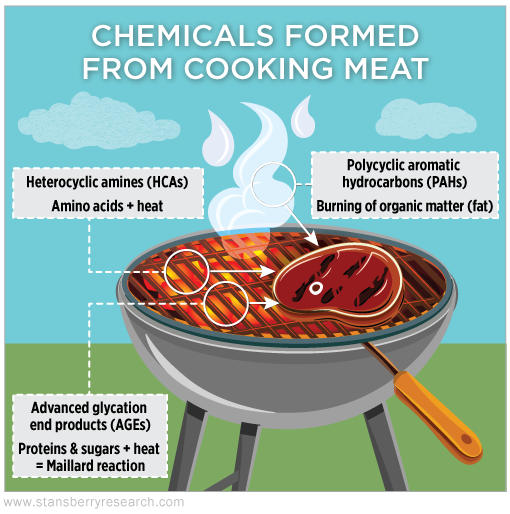I started my third career over a grill...
When my friend and now-business partner Porter Stansberry was recruiting me to begin writing what would become my monthly newsletter, Retirement Millionaire... he had me over for rib appetizers followed by bone-in rib-eyes.
He knew my weakness... good barbecue. How could I not sign on?
Longtime readers already know my love for bacon. And don't even get me started on the juicy, drip-down-your-chin goodness of Maryland's pit beef or a hog at a North Carolina pig pickin'.
But this time of year, at the start of grilling season, I get a lot of questions on the safety of grilling. There are potential dangers to your health from grilling.
I don't want politicians to use the facts I'm about to share with you to ban barbecue or grilling, but I do want you to know the risks and learn the tricks to make your experiences safer.
For barbecuing and grilling, we'll focus on three main compounds known to cause cancer: HCAs, PAHs, and AGEs.
The first are heterocyclic amines ("HCAs"). These chemical compounds form when an amino acid in the meat hits the sugars that are released during cooking. Typically, HCAs form only in high temperatures. Frying, roasting, and grilling all produce HCAs. But there's some evidence that longer cooking periods (think 12-hour barbecues) also produce them.
The second, polycyclic aromatic hydrocarbons ("PAHs"), are much more prevalent in barbecue than in other cooking methods. That's because PAHs form when fat drips down into the heat source and turns to smoke. That smoke contains PAHs... and it seeps into the meat (ever seen the smoke ring on ribs or brisket?). Think about how tasty grilled and barbecued food is – that's all from PAH-filled smoke.
Finally, advanced glycation end products ("AGEs") form when proteins and sugars in the meat start to brown when heated. It's what gives meat its distinct flavor when cooked, and shows as brown color on the outside.
Our bodies make AGEs as normal byproducts. But when we eat, we absorb about 10% of AGEs from the food. What's more, AGEs accumulate in tissue. Several studies show AGEs build up in joints, and they may contribute to osteoarthritis. Other research indicates that AGEs increase oxidative stress and inflammation... In other words, buildup of AGEs contributes to chronic illnesses such as diabetes and heart disease.
Time, temperature, and distance each play major roles in these chemicals forming...
How to Reduce Your Exposure to These Chemicals
Cooking for longer periods and at lower temperatures reduces levels of these compounds. That's why the barbecue "low and slow" method typically means fewer problems. Cooking food to well done or charred means it contains lots of these compounds, including AGEs. If you still choose to grill, try reducing the heat and cooking a bit longer.
But don't overcook your meat... When grilling, I recommend medium or medium-rare temperatures. Research has tied well-done and charred meat to higher risk of colon and pancreatic cancers. In fact, we highly recommend investing in a decent meat thermometer to avoid overcooking. Testing the thickest part of the meat is best. That's because you want to make sure the meat is cooked all the way through.
Similarly, indirect heat cuts the risk of these chemicals. Using cooking methods such as boiling, steaming, or stewing lowers exposure to these compounds. And lowering the temperature also lowers your risk. Cooking a roast in a slow cooker or with a sous vide lowers your exposure, too. Traditional barbecue already uses indirect heat, but you can also set up your grill for more indirect heat. Moving coals to one side and rotating the meat will help achieve this. (See more here and here.)
Deciding which cut of meat you use can help, too. One study from the Food Standards Agency in London found that beef burgers had much higher PAH levels than sausages. The reasons are the higher surface area of the patties and the fact that burgers drip fat down directly into the heat source, which smokes up. The casing of sausages tends to prevent some PAH exposure and keeps fat from dripping as much on the grill. Just remember to turn with tongs and avoid using forks, which poke holes.
The London study found that when fat fell into a drip pan below the meat and not onto the burners, PAH levels dropped 10-fold in the meat. It's a good reason to consider a drip pan or putting foil on your grill.
Overall, researchers tested four different methods of cooking: frying, grilling, barbecuing, and roasting. They tested both professional kitchens and in-home cooking. They also used charcoal, charcoal plus wood, and gas grills. Of all their extensive tests, meat cooked in the charcoal and woodchip barbecues had the highest concentration of PAHs. So if you're really concerned about these extra chemical compounds, consider going with a gas grill.
I'm not about to give up my grilled steaks or slow-cooked barbecue ribs. Instead, try this simple way to cut both HCAs and PAHs: Marinate them.
According to the Journal of Agricultural and Food Chemistry, an easy marinade made from beer cut PAHs by more than half in cooked pork. Similarly, a study from Kansas State University found that spice rubs containing high levels of antioxidants cut HCA formation by 80%.
It's likely the antioxidants doing the trick... So use a beer-spice mix or a nice olive oil and spice mix the next time you grill or barbecue. And don't forget to eat plenty of greens (I prefer arugula) for their antioxidant powers, as well.
What We're Reading...
- Something different: Tick season is back.
Here's to our health, wealth, and a great retirement,
Dr. David Eifrig and the Health & Wealth Bulletin Research Team
May 21, 2024

